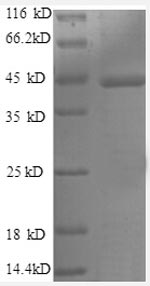Amino acids 120-269 form the expressed segment for recombinant Human CASP1. The theoretical molecular weight of the CASP1 protein is 43.8 kDa. This protein is generated in a e.coli-based system. The N-terminal GST tag was fused into the coding gene segment of CASP1, making it easier to detect and purify the CASP1 recombinant protein in the later stages of expression and purification.
Caspase-1 (CASP1) is a crucial enzyme primarily involved in the regulation of inflammation and apoptosis. One of its key research areas is its role in immune system inflammation regulation. CASP1 is a critical component of the inflammasome, triggering inflammatory responses by activating pro-inflammatory cytokines IL-1β and IL-18, contributing to infection defense and maintaining immune balance. CASP1 is also a subject of interest in the study of inflammatory diseases, showing close associations with autoimmune diseases, neuroinflammation, and the inflammatory processes related to tumors. Researchers aim to uncover the precise regulatory mechanisms of CASP1 in the development of these diseases, hoping to develop relevant therapeutic strategies. Additionally, CASP1 plays a crucial role in the regulation of apoptosis, being involved in the activation of the non-canonical apoptosis pathway, which is essential for maintaining the normal physiological balance of tissues and organs.






